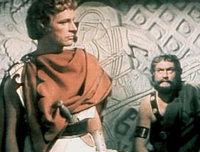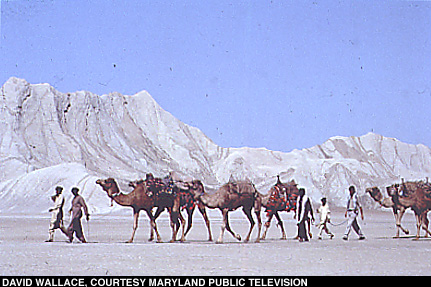Oliver Stone’s epic Alexander finally opens next week. We just did a big hoohaw preview a few days ago, focusing on Pete Green’s survey of recent Alexandrian literature, and in particular Alexander’s evolving image.
Archaeology magazine has just put up an Alexander resource on the web. Included in the section is an interview with the film’s chief historian Robin Lane Fox, which we already discussed back in September, and a review of the 1955 film Alexander the Great, starring Richard Burton:
- From a strictly technical standpoint this is not a good film. The process shots are primitive, the sets are cheap and historically inaccurate, the editing is choppy, the continuity is erratic, it is replete with historical errors, and it seems to have lost its focus as the moody, enigmatic Alexander picked his way across Asia. This film is not even close to the technical quality found in some other sword-and-sandal epics of the period: Quo Vadis, The Robe, The Silver Chalice, and Spartacus, to mention a few. One wonders what drew the distinguished director, Robert Rossen (whose credits include Body and Soul, All the King’s Men, and The Hustler), to this project, unless it was the challenge of commanding the 6,000 soldiers from the Spanish army who served as extras. The shoddiness of the film is most evident in the sequences depicting Alexander’s conquests in Asia–a hurried compression of events and battle scenes interspersed with a few standard Alexander stories. As we watched the film again recently my wife remarked, “So tedious. How can conquering the world be so tedious?” The second half of the film can be missed without loss.
But the early part of the film, even while suffering from the same condition of shooting-on-the cheap, is a serious study of Macedonian court intrigue, dominated by the powerful performances of Fredric March as Philip of Macedon, and of Burton in the title role. This part of the story is based squarely on Plutarch’s Life of Alexander, and it is a faithful rendering of that ancient biographer not only in spirit but also in many details. It accurately captures the mood of court life during Philip’s campaigns in Greece and in the Balkan regions along the Macedonian frontier, during which era Prince Alexander grew into young manhood.

The film emphasizes one of the most complex human stories that we know from antiquity, the ambivalent relationship that existed between the warrior-chief Philip and his talented and ambitious son. There were good reasons for the king to be wary of Alexander and his close relationship with his mother Olympias, now cast aside by Philip. Yet Alexander demonstrated enormous military talent and charismatic leadership, traits that not only threatened Philip but also made him confident that he had fostered a competent comrade and successor.
In adition ot the above review, Eugene Borza also reviews the 1998 PBS series In the Footsteps of Alexander the Great, now aavailable on DVD:
- “To this day no one has traced the whole of Alexander’s great journey on the ground–that was my plan.” Despite Michael Wood’s enormous effort, modern politics prevented him from realizing his goal. Yet this British historian and creator of more than 60 documentaries has come closer to doing so than any of his illustrious predecessors, including the great early twentieth-century British explorer Sir Aurel Stein and the indefatigable mid-century traveler Freya Stark, both of whom intensively explored portions of Alexander’s route. We are grateful to have the record of Wood’s journey across Greece, Turkey, Syria, Lebanon, Israel, Egypt, Iraq, Iran, Afghanistan, Uzbekistan, Tajikistan, Pakistan, and India. It is to his credit that only in Iraq was he prevented by the authorities from following the ground trod by Alexander’s army.
….On an artistic level, however, it is a major achievement that will enrich both scholars and the general public. With stunning images of parts of the world rarely seen by Western eyes, Wood conveys a sense of the extraordinary distances and dramatic campaigns in the difficult country through which Alexander led his army. No book or film has ever before so persuasively conveyed this message.
The effect is cumulative over the four one-hour episodes. The first two segments are a military and cultural travelog involving the ancient itinerary and the modern peoples who inhabit the Turkish and Near Eastern regions conquered by Alexander.
….His itinerary is occasionally enlivened by on-site interviews with specialists, such as one at the location of the Battle of Issus, the scene of Alexander’s victory over the Persian king Darius in 333 B.C., during their first head-to-head encounter. On this famous coastal plain, amid the intrusions of a steel factory, electric power lines, and highway construction, Tulane University professor Kenneth Harl offers an energetic reconstruction of the battle. Later on, the journey into Egypt’s Western Desert to retrace Alexander’s route to the Siwa Oasis provides, perhaps for the first time, a comprehensive visual record of that dramatic landscape.

..Although the political situation in Iraq prevented him from doing ground-level examination there, Wood, innovative as always, managed to hitch a ride on a U.S. Air Force AWACS flight that was monitoring the northern “no-fly zone.” Within this sensitive military zone is the site of the Battle of Gaugamela, where, in 331 B.C., Alexander’s army finally defeated Darius’ forces in one of the largest and most decisive engagements of antiquity. Wood’s discussion of that battle is illustrated from aloft, with a description of the ancient armies’ movements through the terrain as seen on the AWACS’s radar screens.
….it is in the third episode, covering the journey through Afghanistan and the central Asian republics, that the film’s power becomes evident. With Wood, we are stunned by the present-day devastation of Kabul and the loss through looting of the treasures in the great museum there (see “Museum Under Siege”, March/April 1996). The museum director’s comment is touching: “It was as if our mother and father had died. Our whole history was here.” From the ruins of Kabul, Wood follows Alexander’s route across the towering Hindu Kush through the formidable Khawak Pass. He travels by Land Rover, then horse, and finally on foot, all the while recounting the ancient writers’ descriptions of the suffering endured by Alexander’s army from starvation, cold, exhaustion, and altitude sickness. At the head of the 12,000-foot pass, from which the land stretches away into central Asia, Wood notes that after “following Alexander’s footsteps up here with this wind you can really feel, whatever you think about him, what an amazing achievement it was to drive an army over these mountains.”
In episodes three and four, Wood experiences the push to Samarkand, the return to Afghanistan and the crossing of the Khyber Pass into the northwest frontier, the journey down the Indus, and finally the return trek across the Makran Desert toward Persia. The cinematography is so potent that, even after decades of studying Alexander’s career, I understood for the first time the topography of the heretofore impregnable mountain fortress called in antiquity the Rock of Aornos, the modern Pir Sar. Using techniques known today mainly to mountaineers, Alexander’s army climbed those steep heights to engage and defeat Indian enemies who had taken refuge there.
….One major theme that emerges is the enormous impact of Alexander’s life and legend on local people, in coffee houses in northern Greece, in bazaars and tents in central Asia, and along the Indus frontier. The memories exist, deeply embedded in the folk traditions of a vast segment of Earth’s peoples. No matter that many of the memories are hostile. Alexander’s passing is still regarded as a disaster among the Zoroastrians of central Iran, who believe that his destruction of the ancient Persian Empire was an act of evil. To this day they call him “Alexander the Accursed.” I hope the film will provoke cultural anthropologists to conduct a comprehensive study of the Alexander legends recalled by the people who live today along the conqueror’s path….
Borza also reviews The True Story of Alexander the Great, which recently aired on the History Channel and will be out on DVD in December:
- As is customary in such programs, three professorial talking heads soon appeared on the screen–and what talking heads they were! Brian Bosworth and Peter Green are among the greatest living scholars of Alexander, and the third, William Murray, first learned his Alexander as my student many years ago. Thus emboldened by confidence that this was a serious exposition, I relaxed to enjoy a straightforward presentation of the Alexander story. And for good reason, for not only did Bosworth, Green, and Murray provide insightful comments on Alexander’s character, abilities, and motivations, but Green and Murray also served as historical consultants for the project.
….Now, to the usual lot of nit-picking: for example, some Macedonian helmets and shields were not accurately reconstructed; Aristotle did not tutor Alexander in a cave at Mieza (as the film suggests) but rather likely in a stoa built into a rock face; it is not reasonable that the Theban Sacred Band fought naked; the last wife of Philip II did not commit suicide (she was murdered by Alexander’s mother, Olympias); and the evidence now very strongly suggests that the great royal tomb at Vergina is not that of Philip II, but of a later king, probably Alexander’s half-brother Arrhidaeus, who succeeded the conqueror. But these are, in the long run, details that do not jeopardize the value of the program.
….Computer graphics restaging battle scenes are impressive, and, for the most part, accurate, and in a compelling and creative stroke, actors portrayed the ancient authors Arrian, Diodorus, Quintus Curtius Rufus, and Plutarch reciting passages from their works on Alexander.
There’s more, of course, and the new Alexander film itself is just around the corner.
 Blogcritics The critical lens on today's culture & entertainment
Blogcritics The critical lens on today's culture & entertainment



